Marketing 101 Assignment: Article Review and Comparison with Textbook
VerifiedAdded on 2022/09/16
|6
|1114
|22
Homework Assignment
AI Summary
This assignment analyzes three articles and a textbook chapter related to marketing principles. The first article focuses on the importance of relationship marketing in the insurance business, emphasizing customer acquisition and retention through fulfilling promises and fostering mutual cooperation. The second article discusses online marketing, highlighting its cost-effectiveness and global reach while acknowledging potential drawbacks like privacy concerns. The third article examines market segmentation, target marketing, and product positioning, stressing the need for customer-centric strategies and dividing markets into segments. The analysis compares and contrasts the information presented in the articles with corresponding concepts in the textbook, offering a comprehensive understanding of customer relationship management (CRM), internet marketing, and target market strategies. The assignment concludes by emphasizing the significance of these concepts in contemporary marketing practices.

Student Name
INSTITUTIONAL AFFILIATION(S)
MARKETING 101
INSTITUTIONAL AFFILIATION(S)
MARKETING 101
Paraphrase This Document
Need a fresh take? Get an instant paraphrase of this document with our AI Paraphraser

P a g e | 1
Article 1.
Bazinia, E., Elmazi, L., & Sinanaj, S. (2012). Importance of relationship marketing
management in the insurance business in Albania. Procedia - Social and
Behavioural Sciences, 44, 155-162.
Since marketing is closely associated with customers, Bazinia, Elmazi, & Sinanaj
(2012) thinks acquiring customers is very significant for any firm. The authors define
relationship marketing as maintaining, attracting, commercialising and enhancing customer
relationships to foster sales. This can be achieved by fulfilment of the promise and mutual
exchange. Relationship marketing can be established by involving a promise and maintaining
them through the fulfilment of every promise made besides making a new set of promises to
keep consumers engaged.
Bazinia, Elmazi, & Sinanaj (2012) argues that relationship marketing is based on the
fact that customer and providers must cooperate to an extent where a joint process is
established. This will make production and consumption take place simultaneously which
implies marketing managers to create a mutual operation between them and customers rather
create competition and conflicts only. Similarly, Kotter & Armstrong (2008) posits that by
using CRM, firms will be able to understand customers buying behaviour and can target than
more efficiently (p.112).
I believe that both the book and the article impart a good understanding on the
significance behind customer relationship marketing and can provide students with a deeper
meaning behind customer relationship significance in marketing. Moreover, CRM does not
entail any data mining or additional costs associated with it but collects original data only
which are directly related to customers. While maintaining and establishing customer
Article 1.
Bazinia, E., Elmazi, L., & Sinanaj, S. (2012). Importance of relationship marketing
management in the insurance business in Albania. Procedia - Social and
Behavioural Sciences, 44, 155-162.
Since marketing is closely associated with customers, Bazinia, Elmazi, & Sinanaj
(2012) thinks acquiring customers is very significant for any firm. The authors define
relationship marketing as maintaining, attracting, commercialising and enhancing customer
relationships to foster sales. This can be achieved by fulfilment of the promise and mutual
exchange. Relationship marketing can be established by involving a promise and maintaining
them through the fulfilment of every promise made besides making a new set of promises to
keep consumers engaged.
Bazinia, Elmazi, & Sinanaj (2012) argues that relationship marketing is based on the
fact that customer and providers must cooperate to an extent where a joint process is
established. This will make production and consumption take place simultaneously which
implies marketing managers to create a mutual operation between them and customers rather
create competition and conflicts only. Similarly, Kotter & Armstrong (2008) posits that by
using CRM, firms will be able to understand customers buying behaviour and can target than
more efficiently (p.112).
I believe that both the book and the article impart a good understanding on the
significance behind customer relationship marketing and can provide students with a deeper
meaning behind customer relationship significance in marketing. Moreover, CRM does not
entail any data mining or additional costs associated with it but collects original data only
which are directly related to customers. While maintaining and establishing customer

P a g e | 2
relations, the sellers will be obliged to keep promises which are relevant to their goods or
services and in turn, customers will keep their promises and ensure long term profits for the
business.
Article 2.
Bostanshirin, S. (2014). Online Marketing: Challenges and Opportunities. Retrieved
from https://swsu.ru/sbornik-statey/pdf/internet-market-454.pdf
The above article stress on online marketing, also known as internet marketing which
involves virtual and interactive spaces to promote and sell god and services. Internet-based
marketing and communication technologies have contributed immensely to the
restructuration of several economic sectors such as marketing management. Online marketing
proves to be cost-effective, fast and flexible which helps companies in reaching the
unprecedented global marketplace. Internet marketing has provided many businesses with
several gains but then, this method may come with additional drawbacks too like privacy and
security, lack of personal touch and miscommunication which needs to be addressed before
implementing it in marketing strategies.
According to Bostanshirin (2014), marketing is one of several fields that have been
revolutionised through internet and technological innovations. Similarly, Kotter & Armstrong
(2008) documents that today’s business world is connected through digital networks besides
connecting users from every part of the world (p. 493). Both the sources support the notion
that internet and online marketing have provided marketers with new and effective means of
value creation for customers along with customer relationship-building techniques.
After reading the above article and the book, I can say that both the sources contain
valuable information regarding internet marketing as every traditional companies need to set
relations, the sellers will be obliged to keep promises which are relevant to their goods or
services and in turn, customers will keep their promises and ensure long term profits for the
business.
Article 2.
Bostanshirin, S. (2014). Online Marketing: Challenges and Opportunities. Retrieved
from https://swsu.ru/sbornik-statey/pdf/internet-market-454.pdf
The above article stress on online marketing, also known as internet marketing which
involves virtual and interactive spaces to promote and sell god and services. Internet-based
marketing and communication technologies have contributed immensely to the
restructuration of several economic sectors such as marketing management. Online marketing
proves to be cost-effective, fast and flexible which helps companies in reaching the
unprecedented global marketplace. Internet marketing has provided many businesses with
several gains but then, this method may come with additional drawbacks too like privacy and
security, lack of personal touch and miscommunication which needs to be addressed before
implementing it in marketing strategies.
According to Bostanshirin (2014), marketing is one of several fields that have been
revolutionised through internet and technological innovations. Similarly, Kotter & Armstrong
(2008) documents that today’s business world is connected through digital networks besides
connecting users from every part of the world (p. 493). Both the sources support the notion
that internet and online marketing have provided marketers with new and effective means of
value creation for customers along with customer relationship-building techniques.
After reading the above article and the book, I can say that both the sources contain
valuable information regarding internet marketing as every traditional companies need to set
⊘ This is a preview!⊘
Do you want full access?
Subscribe today to unlock all pages.

Trusted by 1+ million students worldwide

P a g e | 3
their own digital and online sales along with communication channels to remain competitive
in the marketplace. From the case study provided in the article, I can say that internet has
changed customers thinking about speed, price, convenience, product information and quality
service and thus, contemporary marketing managers and retailers must focus on how to serve
customers through their online sales and marketing strategies.
Article 3.
Camilleri, M. A. (2018). Market Segmentation, Targeting and Positioning. Retrieved
from https://www.um.edu.mt/library/oar/bitstream/123456789/21433/5/Market
%20Segmentation%20Targeting%20and%20Positioning.pdf
Companies may not be able to position every need of customers which makes difficult
for them to meet exact requirements of the individual customer. Thus, many companies
undertake strategy most commonly known as target marketing which involves dividing
different markets into segments. These segments are further analysed to develop products or
services. Since target marketing is focused majorly upon customers requirements, it is
significant for marketers to develop a customer-centric strategy particularly related to target
markets which the company wants to attempt to.
While Camilleri (2018) argues that marketing managers who consider utilising target
markets usually breaks the market into several groups, also known as segments, Kotter &
Armstrong (2008) claims that every segment differs in terms of locations, resources, buying
practices and wants which require companies to divide market segments into smaller
segments. Unlike information provided in the article, Kotter & Armstrong (2008) argues that
“There is no single way to segment a market” (p. 185). Accordingly, marketers need to try
their own digital and online sales along with communication channels to remain competitive
in the marketplace. From the case study provided in the article, I can say that internet has
changed customers thinking about speed, price, convenience, product information and quality
service and thus, contemporary marketing managers and retailers must focus on how to serve
customers through their online sales and marketing strategies.
Article 3.
Camilleri, M. A. (2018). Market Segmentation, Targeting and Positioning. Retrieved
from https://www.um.edu.mt/library/oar/bitstream/123456789/21433/5/Market
%20Segmentation%20Targeting%20and%20Positioning.pdf
Companies may not be able to position every need of customers which makes difficult
for them to meet exact requirements of the individual customer. Thus, many companies
undertake strategy most commonly known as target marketing which involves dividing
different markets into segments. These segments are further analysed to develop products or
services. Since target marketing is focused majorly upon customers requirements, it is
significant for marketers to develop a customer-centric strategy particularly related to target
markets which the company wants to attempt to.
While Camilleri (2018) argues that marketing managers who consider utilising target
markets usually breaks the market into several groups, also known as segments, Kotter &
Armstrong (2008) claims that every segment differs in terms of locations, resources, buying
practices and wants which require companies to divide market segments into smaller
segments. Unlike information provided in the article, Kotter & Armstrong (2008) argues that
“There is no single way to segment a market” (p. 185). Accordingly, marketers need to try
Paraphrase This Document
Need a fresh take? Get an instant paraphrase of this document with our AI Paraphraser

P a g e | 4
different market segmentation variables in combination with and in isolation to find the best
possible way in viewing market structure.
From materials present in the article, I learnt that marketing managers can consider
the target market to break the market into several groups or segments to target the most
profitable ones. However, the book proves to be more accurate as it reveals how we as
marketers must consider geographic, psychographic, behavioural and demographic variables
of customers. In summary, both the sources can prove significant in making further research
on three critical stages associated with marketing i.e. market segmentation, targeting and
product positioning.
different market segmentation variables in combination with and in isolation to find the best
possible way in viewing market structure.
From materials present in the article, I learnt that marketing managers can consider
the target market to break the market into several groups or segments to target the most
profitable ones. However, the book proves to be more accurate as it reveals how we as
marketers must consider geographic, psychographic, behavioural and demographic variables
of customers. In summary, both the sources can prove significant in making further research
on three critical stages associated with marketing i.e. market segmentation, targeting and
product positioning.

P a g e | 5
References
Bazinia, E., Elmazi, L., & Sinanaj, S. (2012). Importance of relationship marketing
management in the insurance business in Albania. Procedia - Social and Behavioral
Sciences, 44, 155-162.
Bostanshirin, S. (2014). Online Marketing: Challenges and Opportunities. Retrieved from
https://swsu.ru/sbornik-statey/pdf/internet-market-454.pdf
Camilleri, M. A. (2018). Market Segmentation, Targeting and Positioning. Retrieved from
https://www.um.edu.mt/library/oar/bitstream/123456789/21433/5/Market
%20Segmentation%20Targeting%20and%20Positioning.pdf
Kotter, P., & Armstrong, G. (2008). Principles of Marketing (12 ed.). New Jersey: Pearson.
References
Bazinia, E., Elmazi, L., & Sinanaj, S. (2012). Importance of relationship marketing
management in the insurance business in Albania. Procedia - Social and Behavioral
Sciences, 44, 155-162.
Bostanshirin, S. (2014). Online Marketing: Challenges and Opportunities. Retrieved from
https://swsu.ru/sbornik-statey/pdf/internet-market-454.pdf
Camilleri, M. A. (2018). Market Segmentation, Targeting and Positioning. Retrieved from
https://www.um.edu.mt/library/oar/bitstream/123456789/21433/5/Market
%20Segmentation%20Targeting%20and%20Positioning.pdf
Kotter, P., & Armstrong, G. (2008). Principles of Marketing (12 ed.). New Jersey: Pearson.
⊘ This is a preview!⊘
Do you want full access?
Subscribe today to unlock all pages.

Trusted by 1+ million students worldwide
1 out of 6
Your All-in-One AI-Powered Toolkit for Academic Success.
+13062052269
info@desklib.com
Available 24*7 on WhatsApp / Email
![[object Object]](/_next/static/media/star-bottom.7253800d.svg)
Unlock your academic potential
Copyright © 2020–2025 A2Z Services. All Rights Reserved. Developed and managed by ZUCOL.